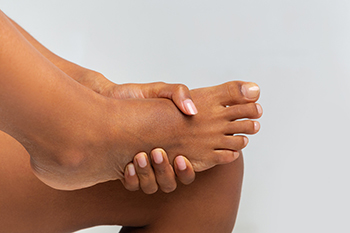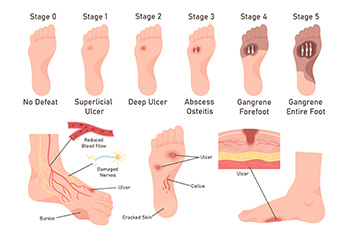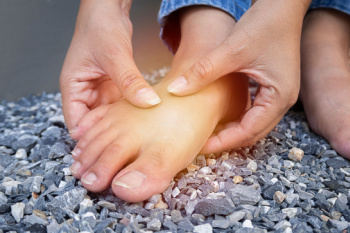September 2024
Wounds That Don't Heal Need to Be Checked
Common Foot Injuries

Painful foot injuries can significantly impact daily life. One common issue is neuromas, painful nerve tumors typically occurring between the toes. Stress fractures, often caused by overuse or sudden increases in activity, result in tiny cracks in the foot bones and cause sharp pain. Plantar fasciitis involves inflammation of the band of tissue running along the bottom of the foot, leading to heel pain, that is noticeable in the morning. Heel spurs on the other hand are bony growths on the heel bone that can cause pain during movement. Foot pain can cause difficulty in completing daily activities. If you have pain in any area of your foot, it is strongly suggested that you schedule an appointment with a podiatrist who can offer appropriate treatment solutions.
Foot Pain
Foot pain can be extremely painful and debilitating. If you have a foot pain, consult with Dr. Robert Marcus from Foot & Ankle Center of Teaneck. Our doctor will assess your condition and provide you with quality foot and ankle treatment.
Causes
Foot pain is a very broad condition that could be caused by one or more ailments. The most common include:
- Bunions
- Hammertoes
- Plantar Fasciitis
- Bone Spurs
- Corns
- Tarsal Tunnel Syndrome
- Ingrown Toenails
- Arthritis (such as Gout, Rheumatoid, and Osteoarthritis)
- Flat Feet
- Injury (from stress fractures, broken toe, foot, ankle, Achilles tendon ruptures, and sprains)
- And more
Diagnosis
To figure out the cause of foot pain, podiatrists utilize several different methods. This can range from simple visual inspections and sensation tests to X-rays and MRI scans. Prior medical history, family medical history, and any recent physical traumatic events will all be taken into consideration for a proper diagnosis.
Treatment
Treatment depends upon the cause of the foot pain. Whether it is resting, staying off the foot, or having surgery; podiatrists have a number of treatment options available for foot pain.
If you have any questions, please feel free to contact our office located in Teaneck, NJ . We offer the newest diagnostic and treatment technologies for all your foot care needs.
Managing Diabetic Foot Ulcers

A diabetic foot ulcer is a common complication of diabetes, characterized by open sores or wounds that develop on the feet, often due to poor circulation and neuropathy. These ulcers can result from minor injuries or pressure points and can be slow to heal, posing a risk of infection. Finding relief involves several steps. Firstly, controlling blood sugar levels is essential to promote healing. Regularly inspecting and cleaning the ulcer with mild soap and water helps prevent infection. Using appropriate wound dressings and ensuring the affected foot is kept dry and protected is also important. Offloading pressure through custom orthotic devices or specialized footwear can aid in healing. Seeking prompt medical attention from a podiatrist for advanced treatments, such as debridement or antibiotics, ensures effective management and reduces the risk of complications. If you have diabetes or have developed a foot ulcer, it is suggested that you are under the care of a podiatrist who can effectively treat foot wounds.
Wound care is an important part in dealing with diabetes. If you have diabetes and a foot wound or would like more information about wound care for diabetics, consult with Dr. Robert Marcus from Foot & Ankle Center of Teaneck. Our doctor will assess your condition and provide you with quality foot and ankle treatment.
What Is Wound Care?
Wound care is the practice of taking proper care of a wound. This can range from the smallest to the largest of wounds. While everyone can benefit from proper wound care, it is much more important for diabetics. Diabetics often suffer from poor blood circulation which causes wounds to heal much slower than they would in a non-diabetic.
What Is the Importance of Wound Care?
While it may not seem apparent with small ulcers on the foot, for diabetics, any size ulcer can become infected. Diabetics often also suffer from neuropathy, or nerve loss. This means they might not even feel when they have an ulcer on their foot. If the wound becomes severely infected, amputation may be necessary. Therefore, it is of the upmost importance to properly care for any and all foot wounds.
How to Care for Wounds
The best way to care for foot wounds is to prevent them. For diabetics, this means daily inspections of the feet for any signs of abnormalities or ulcers. It is also recommended to see a podiatrist several times a year for a foot inspection. If you do have an ulcer, run the wound under water to clear dirt from the wound; then apply antibiotic ointment to the wound and cover with a bandage. Bandages should be changed daily and keeping pressure off the wound is smart. It is advised to see a podiatrist, who can keep an eye on it.
If you have any questions, please feel free to contact our office located in Teaneck, NJ . We offer the newest diagnostic and treatment technologies for all your foot care needs.
Relief Options for Hammertoe

Hammertoe is a deformity where one of the toes, often the second, becomes bent in a fixed Z-shaped position. This causes discomfort and difficulty in wearing certain types of shoes and walking. Hammertoe is often the result of tendon imbalances, long metatarsal bones, and poor joint alignment. Rheumatoid arthritis, genetics, or prolonged wearing of ill-fitting shoes are other factors. The bent position of the toe can lead to excessive friction, which can result in painful calluses, corns, and even open sores on top of the affected toe. Treatment options typically involve wearing shoes with a wider toe box to reduce irritation, using orthotic devices to alleviate pain in the ball of the foot, and taping or splinting the toe to provide temporary relief. In more severe cases, where the toe is rigidly fixed and pain persists, surgery may be required to straighten the toe. If you have a painful hammertoe, it is suggested that you schedule an appointment with a podiatrist for a diagnosis and treatment options.
Hammertoe
Hammertoes can be a painful condition to live with. For more information, contact Dr. Robert Marcus from Foot & Ankle Center of Teaneck. Our doctor will answer any of your foot- and ankle-related questions.
Hammertoe is a foot deformity that affects the joints of the second, third, fourth, or fifth toes of your feet. It is a painful foot condition in which these toes curl and arch up, which can often lead to pain when wearing footwear.
Symptoms
- Pain in the affected toes
- Development of corns or calluses due to friction
- Inflammation
- Redness
- Contracture of the toes
Causes
Genetics – People who are genetically predisposed to hammertoe are often more susceptible
Arthritis – Because arthritis affects the joints in your toes, further deformities stemming from arthritis can occur
Trauma – Direct trauma to the toes could potentially lead to hammertoe
Ill-fitting shoes – Undue pressure on the front of the toes from ill-fitting shoes can potentially lead to the development of hammertoe
Treatment
Orthotics – Custom made inserts can be used to help relieve pressure placed on the toes and therefore relieve some of the pain associated with it
Medications – Oral medications such as anti-inflammatories or NSAIDs could be used to treat the pain and inflammation hammertoes causes. Injections of corticosteroids are also sometimes used
Surgery – In more severe cases where the hammertoes have become more rigid, foot surgery is a potential option
If you have any questions please contact our office located in Teaneck, NJ . We offer the newest diagnostic and treatment technologies for all your foot and ankle needs.
What Is Erythromelalgia?

Erythromelalgia is a rare condition resulting in intense burning pain, redness, and warmth in the feet, often triggered by heat, exercise, or stress. This condition occurs due to abnormal blood flow and increased skin temperature in the affected areas, which leads to discomfort that can be severe and debilitating. The exact cause of erythromelalgia is not always clear, but it may be linked to nerve damage or blood vessel abnormalities. In some cases, it is associated with other medical conditions, such as autoimmune disorders or blood diseases. Symptoms include episodes of severe burning pain, redness, and swelling in the feet, which may last from minutes to hours. These episodes can be unpredictable, causing significant disruption to daily life. Diagnosis is usually made based on symptoms and clinical examination, sometimes supported by tests to rule out other conditions. Treatment focuses on managing symptoms, often through cooling measures, medications, and in some cases, addressing underlying conditions. If you are suffering from any of the symptoms described, it is strongly suggested that you visit a podiatrist for care.
When dealing with systemic disease of the feet, it is extremely important to check the affected areas routinely so that any additional problems are caught quickly. If you have any concerns about your feet and ankles contact Dr. Robert Marcus from Foot & Ankle Center of Teaneck. Our doctor will assist you with all of your podiatric needs.
Systemic Diseases of the Feet
Systemic diseases affect the whole body, and symptoms usually are displayed in the feet. This condition can make a patient’s ability to walk unbearable. Systemic diseases include gout, diabetes mellitus, neurological disorders, and arthritis.
Gout – is caused by an excess of uric acid in the body. Common symptoms include pain, inflammation, and redness at the metatarsal/phalangeal joint of the base big toe. Gout can be treated by NSAIDs to relieve pain and inflammation, and other drugs that lower the acid levels in the body.
Diabetes mellitus – is an increase in the level of blood sugar that the body cannot counteract with its own insulin. Failure to produce enough insulin is a factor in Diabetes.
Diabetes of the Feet
Diabetic Neuropathy – may lead to damaged nerves and affect the feet through numbness and loss of sensation.
Peripheral Vascular Disease – can restrict the blood flow to the feet, and often times lead to amputation of the feet.
If you have any questions please feel free to contact our office located in Teaneck, NJ . We offer the newest diagnostic and treatment technologies for all your foot and ankle needs.






